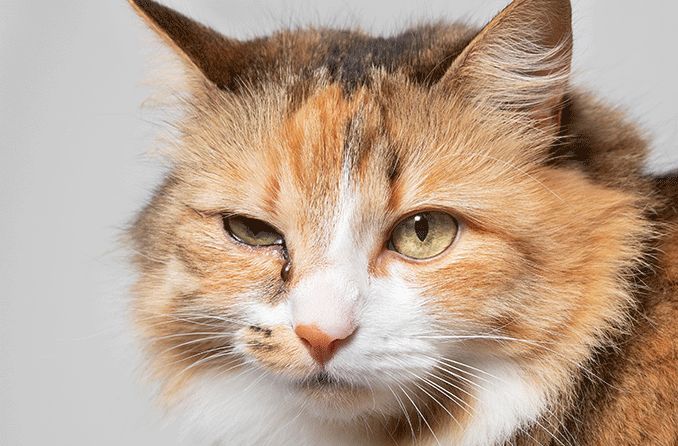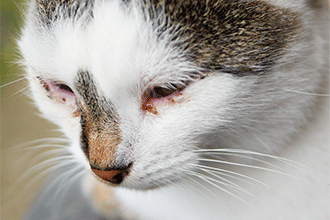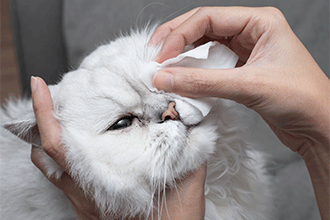What causes eye discharge in cats?

What is eye discharge in cats?
When a cat’s eyes are not draining properly, a brownish eye discharge (epiphora) occurs due to an overflow of tears. The discharge can usually be wiped away with a damp cloth and isn’t a serious issue. But oftentimes, eye discharge in cats can be a sign of ocular disease, an eye infection or other eye problems and should be checked out by a veterinarian.
Eye discharge symptoms
When a cat’s eyes work properly, a thin film of tears lubricates the eyes, and excess fluid drains into the nasolacrimal ducts, which are located in the inside corners of the eyes, and into the nasal cavity. These ducts drain tears into the back of the throat and nose, but when there is damage to the ducts, they can become clogged, creating discharge.
Clear, watery ocular discharge is usually indicative of a minor problem with the eye. If the discharge becomes cloudy, bloody or foul smelling, the problem is more severe and needs veterinary attention.
There are several symptoms that commonly occur along with eye discharge in a cat. These symptoms should be taken seriously, as ocular issues can become severe very quickly and lead to more serious damage to the affected eye:

Skin irritation
Swelling and eye inflammation
Reddish-brown staining beneath the eyes
Impaired vision
Squinting
Cloudy or opaque corneas
SEE RELATED: Cat eyes and vision
| For cat owners: |
|---|
| Are you or is someone in your household allergic to pet dander? If Kitty is causing your eyes to itch or water, visit a local eye doctor. They can help you find a solution so you and Kitty can live together in harmony... without all the tears. |
Causes of eye discharge in cats
The shape of a cat’s face may play a role in ocular discharge because some breeds, such as Himalayans and Persians, have a flat face that doesn’t allow the tears to properly drain.
Sometimes the hair around the eyes wicks away tears and collects dirt and debris, causing irritation and increased tear production. In these cases, some degree of ocular discharge will likely persist. Other causes of eye discharge in cats include:
Allergies, which can case an eye problem in cats.
Feline upper respiratory infection (URI): URIs (also known as cat flu) are a common cat health problem. They are contagious and spread quickly between cats. Some of these diseases can be quite severe and frequently lead to scarring and blockage of the nasolacrimal ducts.
Trauma (fighting is a common cause of eye trauma).
Dry eye, which can lead to an inflamed cornea, possible permanent corneal scarring and even blindness.
Eye infections, whether viral infections or a bacterial infection.
Cat conjunctivitis (like pink eye in humans), an inflammation of the light pink lining around the cat’s eye. The conjunctiva will be swollen and red, and the cat may be sensitive to light and have difficulty opening its eyes.
Glaucoma, which will cause the eyeball itself to swell as a result of a problem inside the eye.
Cancer.
Entropion, a hereditary defect of the eyelids, causing them to roll inward. The lashes and the hair of the eyelid constantly rakes across the cornea. This is quite painful and can lead to corneal ulcers, corneal scarring and blindness. This condition can only be corrected surgically.
SEE RELATED: What is the third eyelid in cats?
How to treat eye discharge in cats

Most epiphora, or watery discharge, in the corners of your cat’s eyes can simply be wiped away with a soft cloth or tissue. If the drainage seems excessive or smells, seek veterinary care.
If the tear duct is blocked, your vet may sedate the cat and insert an instrument into the nasolacrimal (or tear) duct to flush out the blockage so that it can drain more easily.
Clear ocular discharge with a brownish tint can be a permanent condition, but there are some ways to lessen the staining. There are over-the-counter wipes that help, but avoid any products that contain hydrogen peroxide since they can cause severe damage when used near the eyes.
When to seek veterinary care
If the ocular discharge is cloudy, bloody or foul smelling, you should seek veterinary attention as soon as possible. Ocular problems can worsen within hours.
Also, seek veterinary care if your feline friend seems sensitive to light, if there is swelling of the conjunctiva or the eyeball itself, or the cornea appears abnormal.
***Some ocular diseases in cats can be transmissible to humans, so you should wash your hands after handling any cat with an ocular discharge and carefully avoid touching your face.***
READ RELATED: Eye discharge in dogs
Page published on Tuesday, December 29, 2020




